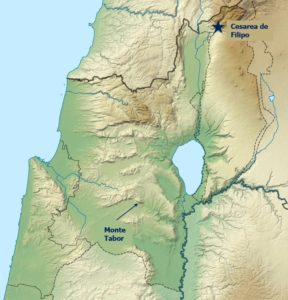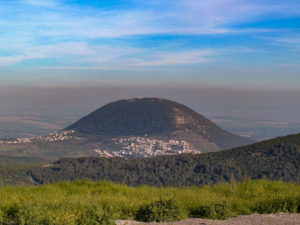A public bus rides from the Damascus Gate in Jerusalem to a neighborhood called al-Tur located at the summit of the Mount of Olives, also known as Jabal al-Tur. It is with this term that the Samaritans of Mount Gerizim, the Arabs of the villages at the foot of Mount Tabor, and the Bedouins around Mount Sinai refer to their sacred mountain. In Arabic, jabal means “mountain.” Tur comes from Aramaic and also means mountain. In one way or another, these four mountains are sacred to Jews, Samaritans, Christians, and Muslims. For these religions, they represent “the mountain” par excellence.
While there is no doubt about the approximate location of Mounts Gerizim, Sinai, and the Mount of Olives, the scene of the Transfiguration has been placed in various locations.

Map Mount Tabor by Henri Gourinard
Saint Peter, in his second epistle (2 Peter 1:17-18), refers rather succinctly to the event of which he was a witness:
“For he received honor and glory from God the Father when that unique declaration came to him from the majestic glory, “This is my Son, my beloved, with whom I am well pleased.” We ourselves heard this voice come from heaven while we were with him on the holy mountain.”
“The holy mountain”: this is the only description provided by Saint Peter. The fact that, in the Old Testament, the term “holy mountain” always appears in the context of Jerusalem—as a synonym for Mount Zion or the Temple Mount (Psalms 2:6; Wisdom 9:8; Isaiah 11:9; Ezekiel 20:40; Joel 2:1; etc.)—led some ancient authors and pilgrims to think that Jesus was transfigured on the Mount of Olives, from which He also ascended to Heaven.
However, most ancient Christian authors believed that Mount Tabor was the site of the Transfiguration. Commenting on Psalm 88:13 (89:12), which contrasts Tabor with Mount Hermon, Origen asserts that “Tabor, the chosen one (eklekton), […] is the mountain in Galilee where Jesus was transfigured (metamorphoté)” (Selecta in Psalmos Ps 88:13/98:12).
There is no disputing the location of Mount Tabor: it appears numerous times in the Old Testament. Among many episodes, the battle fought by Judge Deborah and her general Barak against the Canaanite general Sisera stands out (Judges 4:6). The synoptic Gospels, however, do not provide another topographical indication about the place of the Transfiguration other than that Jesus took Peter, James, and John and led them up “to a high mountain” (Matthew 17:1; Mark 9:2) or simply “up the mountain” (Luke 9:28).

Mont Tabor Nazareth, by Almog Mo
If topography is not helpful, we can consider the chronology. The same Gospels indicate that this occurred a week — “six days” according to Matthew and Mark; “eight days” according to Luke — after Saint Peter’s confession in Caesarea Philippi, a city about 90 kilometers from Mount Tabor. The distance is reasonable.
Certainly, there is no shortage of mountains in this region of Galilee, but none of them can be considered “high”: Mount Gilboa, above Beit She’an; Mount Moreh, opposite Nazareth; and even Mount Carmel. And although Tabor does not rise more than 575 meters, it is the highest mountain in the area. Moreover, due to its geological formation as a “monadnock,” it stands out prominently over the Esdraelon Valley. Along its foothill runs the Via Maris, a key axis of communication linking inland Syria (Damascus) with the Mediterranean ports (Akko-Ptolemais, Caesarea Maritima, Jaffa, Gaza…). The proximity of Mount Tabor to Nazareth (9 km) is also noteworthy. The Child Jesus must have contemplated it many times during His escapades outside the family home.
By Henri Gourinard
